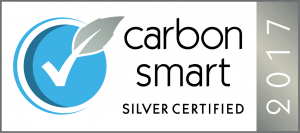Carbon Smart Programme
Cherwell is participating in carbon smart programme to be a more ethical sustainable organisation.
 We have been a carbon smart organisation since 2013, and in 2014 we reduced our CO2 emissions by 18% allowing us to move from the Carbon Smart Blue level to the Silver level, second highest of the three levels of certification available. This was an excellent achievement to make in such a small period of time, with CO2e from our fleet of vans being cut by over 20 tonnes.
We have been a carbon smart organisation since 2013, and in 2014 we reduced our CO2 emissions by 18% allowing us to move from the Carbon Smart Blue level to the Silver level, second highest of the three levels of certification available. This was an excellent achievement to make in such a small period of time, with CO2e from our fleet of vans being cut by over 20 tonnes.
In 2015 we managed to reduce our Carbon Footprint again from 135 tonnes CO2e to 127.5 tonnes CO2e
The Carbon Smart Certification Programme recognises and promotes organisations of all types and sizes that have taken clear practical action to improve their environmental performance. By participating in the Carbon Smart Certification we commit to taking comprehensive and effective action to achieve year on year reductions in our carbon footprint and integrate carbon and energy management within our organisation.
Cherwell’s Carbon Target
We have established our carbon footprint for 2015 is 4.6 CO2e tonnes per employee (a reduction of 10% from last year) as per the established Green House Gas Protocol produced by the World Resources Institute and the World Business Council for Sustainable Development. This assessment was based on the ‘operational boundary principle’ and is thus associated with operations directly influenced by our organisation.
Our 2015 footprint is made up of the following elements:
• Delivery vehicles (56%)
• Electricity (26%)
• Field sales team vehicles (15%)
• Other – water, waste, paper (3%)
Carbon Reduction Action Plan
Our carbon reduction action plan focuses on all areas of our business but with particular concentration on those areas where our carbon footprint is greatest: vehicle fleet management and energy consumption.
Delivery vehicle fleet
Our objective here is to reduce fuel consumption by volume by 15% on current levels.
Key actions include:
- Driver efficiency training using the ‘Safe and Smart Driving Training’ course provided by the Energy Saving Trust
- Daily maintenance checks to ensure that tyre condition and tyre pressures are at the optimal level for efficient fuel consumption
- Running an incentive scheme for delivery fleet drivers which recognises efficient driving in terms of reduced petrol consumption per journey mile
- Continual review of delivery routes in order to ensure maximum loading on vehicles
- Encouraging order frequency reduction and load consolidation on the part of customers through incentives
- As part of the vehicle replacement cycle, introduction of vehicles using fuel efficient alternatives such as biodiesel or LPG
Sales vehicle fleet
Our objective here is to reduce fuel consumption by volume by 15% on current levels.
Key actions include:
- Providing an incentive scheme for the field sales team which recognises a reduction in journey miles by better sales appointment meeting planning
- Driver efficiency training using the ‘Safe and Smart Driving Training’ course provided by the Energy Saving Trust
- Introduction of the use of video conferencing as opposed to face to face meetings as a means of reducing journey miles
Energy
Electricity currently provides all energy used in our premises. Our objective here is to reduce energy consumption by volume by 15% on current levels.
Key actions include:
- Install sensor lights as appropriate in poorly used areas of the warehouse
- Upgrade warehouse T8 lighting on the replacement cycle to T5 energy saving lighting
- Upgrade all office accommodation lighting to compact fluorescent lamps
- Control temperature settings such that heat settings are maintained in the band 19 to 24 degrees centigrade.
- Control heating timers such as heating is turned off one hour before 75% of the staff leave in the evening
 Make an enquiry
Make an enquiry 01926 817 585
01926 817 585